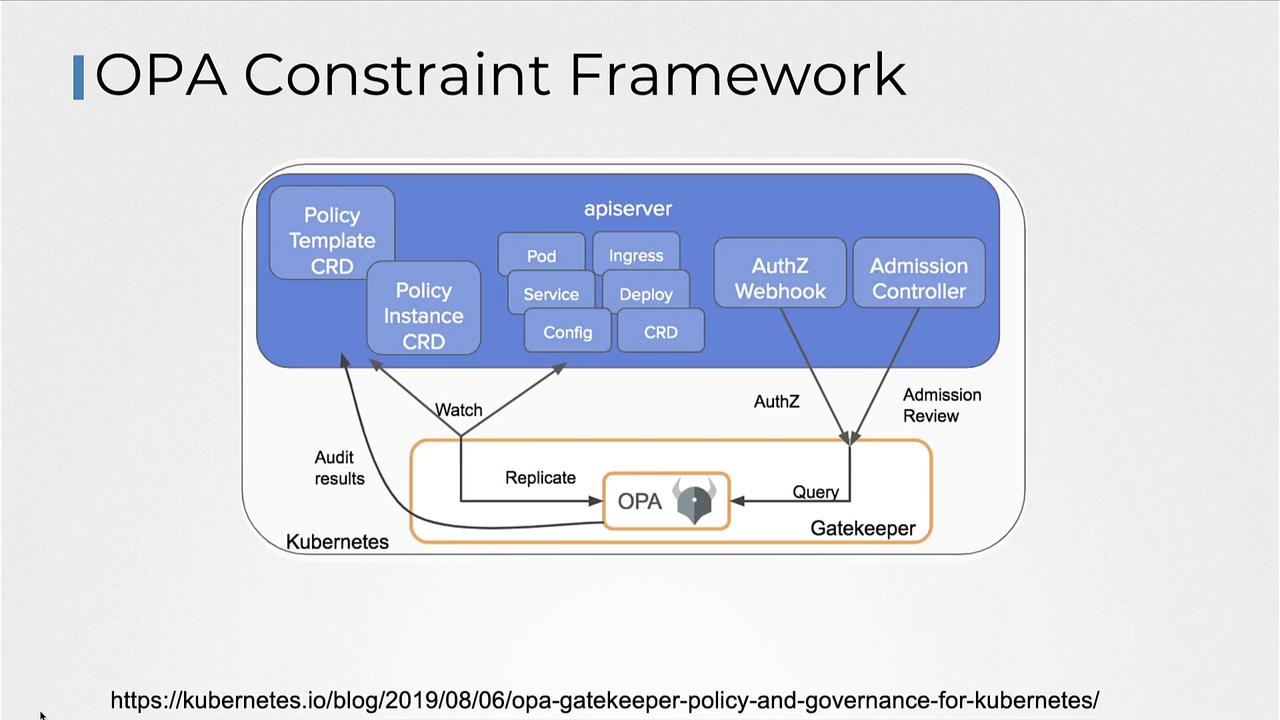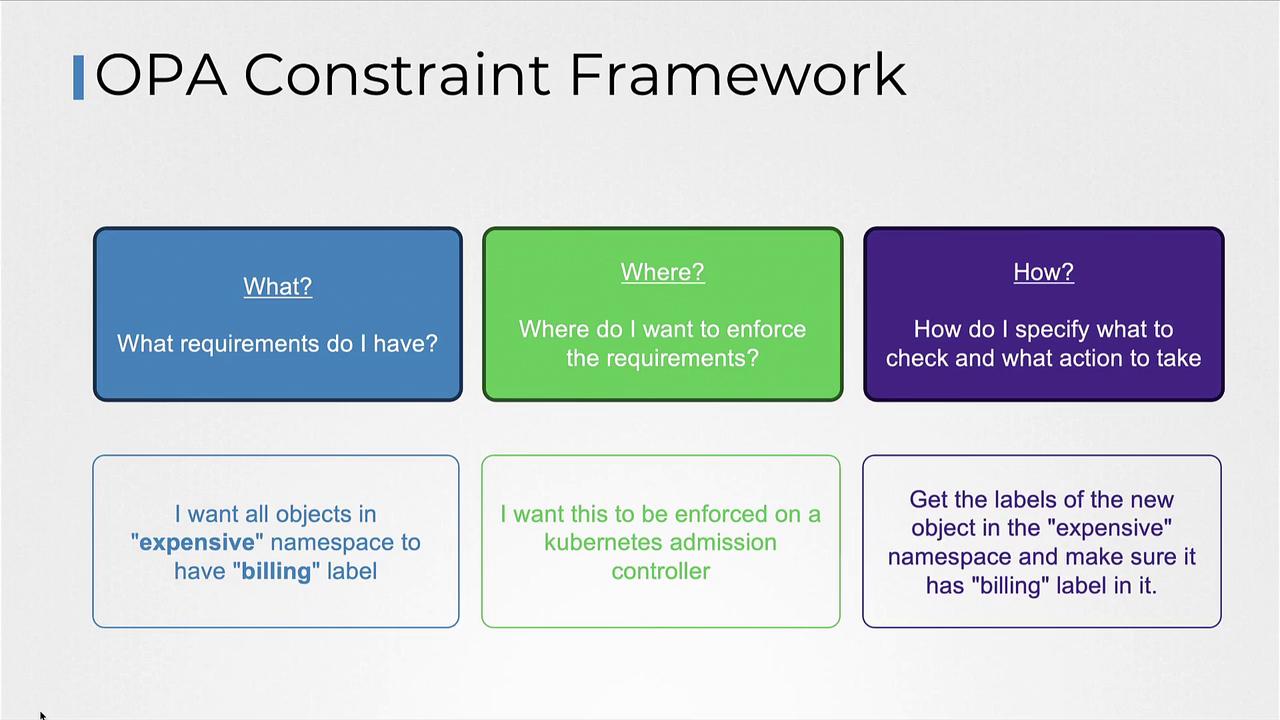Certified Kubernetes Security Specialist (CKS)
Minimize Microservice Vulnerabilities
OPA in Kubernetes
In this article, we explore the integration of OPA (Open Policy Agent) with Kubernetes using the Gatekeeper approach. This method leverages the OPA Constraint Framework alongside Kubernetes admission controllers for enhanced policy enforcement and governance.

With the Gatekeeper approach, the admission controller collaborates with the OPA Constraint Framework by using CRD-based (Custom Resource Definition) policies. This facilitates easier policy sharing and builds trust across your Kubernetes environment.
Before diving into the details of the OPA Constraint Framework, let’s review how to deploy OPA Gatekeeper in Kubernetes.
Installing OPA Gatekeeper
Deploying OPA Gatekeeper is simple. Execute the following command to apply the Gatekeeper specification files:
kubectl apply -f https://raw.githubusercontent.com/open-policy-agent/gatekeeper/v3.14.0/deploy/gatekeeper
After deployment, verify that all Gatekeeper components are installed and running in the gatekeeper-system namespace:
kubectl get all -n gatekeeper-system
Expected output:
NAME READY STATUS RESTARTS AGE
pod/gatekeeper-audit-6699999786d-6n8xt 1/1 Running 1 (12s ago) 31s
pod/gatekeeper-controller-manager-854f95df4f-dbhp7 1/1 Running 0 31s
pod/gatekeeper-controller-manager-854f95df4f-k96kj 1/1 Running 0 31s
pod/gatekeeper-controller-manager-854f95df4f-zfnbw 1/1 Running 0 31s
NAME TYPE CLUSTER-IP EXTERNAL-IP PORT(S) AGE
service/gatekeeper-webhook-service ClusterIP 172.20.60.127 <none> 443/TCP 31s
NAME READY UP-TO-DATE AVAILABLE AGE
deployment.apps/gatekeeper-audit 1/1 1 1 31s
deployment.apps/gatekeeper-controller-manager 3/3 3 3 31s
NAME DESIRED CURRENT READY AGE
replicaset.apps/gatekeeper-audit-6699999786 1 1 1 31s
replicaset.apps/gatekeeper-controller-manager-854f95df4f 3 3 3 31s
Tip
Ensure that you have adequate RBAC permissions before deploying Gatekeeper in your cluster.
Understanding the OPA Constraint Framework
The OPA Constraint Framework allows you to declare policies that specify required conditions, enforce those conditions at the appropriate locations, and define the checks to be performed. For example, if you want all objects in a specific namespace (e.g., "example") to include a "billing" label, the framework will enforce this rule via the Kubernetes admission controller.
When a pod creation request is submitted, the admission controller follows these steps:
- Retrieve the labels from the pod.
- Verify if the required label (e.g., "billing") is present.
- Return an error if the label is missing.

Implementing Label Validation with Rego
Below is an example of Rego code that validates the presence of a required label (e.g., "billing") on a pod. The code compares the provided labels with a hard-coded required label.
Example 1
package systemrequiredlabels
import data.lib.helpers
violation["msg": msg, "details": {"missing_labels": missing}} {
provided := {label | input.request.object.metadata.labels[label]}
required := {label | label == ["billing"]}
missing = required - provided
count(missing) > 0
msg = sprintf("you must provide labels: %v", [missing])
}
Example 2
A similar rule with a slightly different format:
package systemrequiredlabels
import data.lib.helpers
violation["msg"] = msg {
details := {"missing_labels": missing}
provided := {label | input.request.object.metadata.labels[label]}
required := {label | label := ["billing"]}
missing = required - provided
count(missing) > 0
msg = sprintf("you must provide labels: %v", [missing])
}
Example 3
An alternative format with syntactical differences:
package systemrequiredlabels
import data.lib.helpers
violation["msg": msg, "details": {"missing_labels": missing}} {
provided := {label | input.request.object.metadata.labels[label]}
required := {label | label = ["billing"]}
missing := required - provided
count(missing) > 0
msg = sprintf("you must provide labels: %v", [missing])
}
In these examples:
- The
providedvariable extracts labels from the incoming pod object. - The
requiredset is fixed to include "billing". - The
missingvariable determines any labels from therequiredset that are absent. - If any required labels are missing (
count(missing) > 0), an error message is generated.
Extending the Use Case with Parameterization
To support more dynamic scenarios—such as enforcing different labels based on the namespace—you can create a Constraint Template. This enables you to pass the required label as a parameter instead of hardcoding it.
Below is an example Constraint Template that encapsulates the Rego code while exposing a parameter for the required label:
apiVersion: templates.gatekeeper.sh/v1
kind: ConstraintTemplate
metadata:
name: systemrequiredlabels
spec:
crd:
spec:
names:
kind: SystemRequiredLabel
validation:
# Schema for the 'parameters' field goes here
targets:
- target: admission.k8s.gatekeeper.sh
rego: |
package systemrequiredlabels
import data.lib.helpers
violation[{"msg": msg, "details": {"missing_labels": missing}}] {
provided := {label | input.request.object.metadata.labels[label]}
# Use the parameter passed in the constraint instead of hardcoding
required := {label | label == input.parameters.labels[_]}
missing = required - provided
count(missing) > 0
msg = sprintf("you must provide labels: %v", [missing])
}
Once your Constraint Template is ready, define specific constraints to enforce policies for different namespaces. For instance:
Constraint for Billing Label
apiVersion: constraints.gatekeeper.sh/v1beta1
kind: SystemRequiredLabel
metadata:
name: require-billing-label
spec:
match:
namespaces: ["expensive"]
parameters:
labels: ["billing"]
Constraint for Tech Label
apiVersion: constraints.gatekeeper.sh/v1beta1
kind: SystemRequiredLabel
metadata:
name: require-tech-label
spec:
match:
namespaces: ["engineering"]
parameters:
labels: ["tech"]
These constraints dynamically pass the required labels via the input.parameters object in Rego based on the namespace.
Summary
Below is a quick reference table summarizing the key steps for integrating OPA with Kubernetes using Gatekeeper:
| Step | Description | Example Command/Definition |
|---|---|---|
| Install OPA Gatekeeper | Deploy Gatekeeper components using Kubernetes manifests. | kubectl apply -f [Gatekeeper URL] |
| Verify Deployment | Check that all Gatekeeper components are running. | kubectl get all -n gatekeeper-system |
| Validate Labels with Rego | Use Rego code to compare provided and required labels. | See provided Rego examples |
| Create Constraint Template | Define a CRD that accepts dynamic parameters for labels. | Provided YAML for Constraint Template |
| Define Constraint Resources | Enforce policies on specific namespaces with parameters. | Provided YAML for require-billing-label and require-tech-label |
Important
Any object creation that violates the defined policies will trigger an error during the admission phase, preventing non-compliant objects from being admitted into the cluster.
Example Files
requiredlabels-template.yaml
apiVersion: templates.gatekeeper.sh/v1
kind: ConstraintTemplate
metadata:
name: systemrequiredlabels
spec:
crd:
spec:
names:
kind: SystemRequiredLabel
validation:
# Schema for the 'parameters' field goes here
targets:
- target: admission.k8s.gatekeeper.sh
rego: |
package systemrequiredlabels
import data.lib.helpers
violation[{"msg": msg, "details": {"missing_labels": missing}}] {
provided := {label | input.request.object.metadata.labels[label]}
required := {label | label == input.parameters.labels[_]}
missing = required - provided
count(missing) > 0
msg = sprintf("you must provide labels: %v", [missing])
}
require-label-billing.yaml
apiVersion: constraints.gatekeeper.sh/v1beta1
kind: SystemRequiredLabel
metadata:
name: require-billing-label
spec:
match:
namespaces: ["expensive"]
parameters:
labels: ["billing"]
Apply these configurations with the following commands:
kubectl apply -f requiredlabels-template.yaml
kubectl apply -f require-label-billing.yaml
# Output: Constraint require-billing-label created
With these steps in place, any new Kubernetes object that fails to meet the policy requirements will be rejected at admission time, ensuring continued compliance within your cluster.
That concludes our exploration of integrating OPA with Kubernetes using Gatekeeper. Experiment with these policies in your environment to tailor enforcement to your specific needs.
For further details on OPA and Kubernetes, consider visiting:
Watch Video
Watch video content
Practice Lab
Practice lab